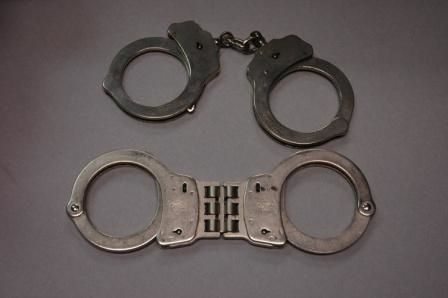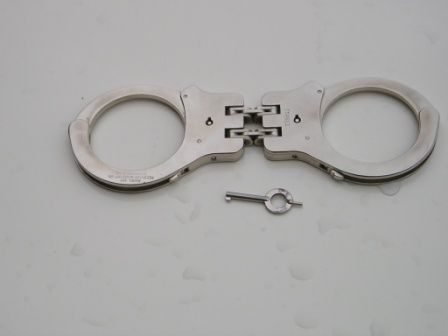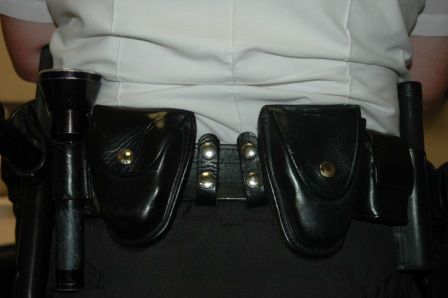Handcuffs: What’s In Your Case?
The two main types of handcuffs used by law enforcement are chain-link cuffs and hinged cuffs. The top image is of a pair of chain-linked handcuffs. Most police officers prefer to carry and use chain-linked cuffs because the chain connecting the two cuffs swivels, making the restraint flexible and easier to apply to the wrists of combative suspects.
The lower image is of a pair of hinged cuffs. These are more commonly used when transporting prison or jail inmates. However, some officers do prefer to carry the hinged cuffs as part of their regular duty/street gear. Hinged cuffs are not flexible (the hinge between the two bracelets does not swivel) which greatly reduces wrist and hand movement. This type cuff is difficult to apply to the wrists during a scuffle, but the lack of flexibility helps prevent lock picking and other furtive movements by prisoners.
Both style cuffs operate using a ratchet and pawl locking system. Both are equipped with a second lock (double-locking) to prevent any further tightening of the ratchet which can injure the wrists of the cuffed suspect. The second lock also prevents prisoners from picking the lock.
The standard handcuff key is pictured above. The L-shaped end of the key is used for unlocking the cuffs, while the prong on the opposite end of the key (at the O, which is used to grip the key between the fingers) is used for double-locking the restraints. To double-lock, the officer inserts the prong into the round holes at the base of the cuff (one on each cuff).
Handcuffs are normally carried in a case (the officer above carries two sets of cuffs) at the center of the small of the back to allow for easy access with either hand.
* This post is in response the questions we received last week regarding the officer’s gun belt. This is actually a re-do of the very first post on The Graveyard Shift, over three years ago.
* Author Melanie Atkins will be joining us tomorrow as a special guest reviewer of this week’s episode of Castle. Melanie is one of Castle’s most devoted fans, so it’ll be fun to hear her take on the show. Of course, I’ll still have my say. Will we butt heads? We’ll see.







Hi Jonathan. The key pictured above is the style that comes with a new pair of cuffs. There are several other styles available, but they work the same. Yes, they’re pretty much universal.
The key must be turned all the way to the right (a quarter turn, or so), and then all the way to the left, to release the double locks.
I’m glad people are talking about the WPA. It would help a lot if they’d register…
The key looks pretty simple – much simpler than I expected.
Are handcuff keys more or less universal? (That would suggest that a cuffed fugitive who manages to escape custody, and has help waiting, could discard the cuffs quickly.)
Also, is the double lock released by opening the key lock, or is there more to it than that?
As an aside – I attended the Love is Murder conference in Chicago this weekend. I heard the WPA mentioned a few times, by both during panels and while mingling. You have made an impact.
I thought the handcuff demo at Writers Police Academy was extremely interesting. Unfortunately, I had to leave early for my FATS training. So many great things to do at WPA!